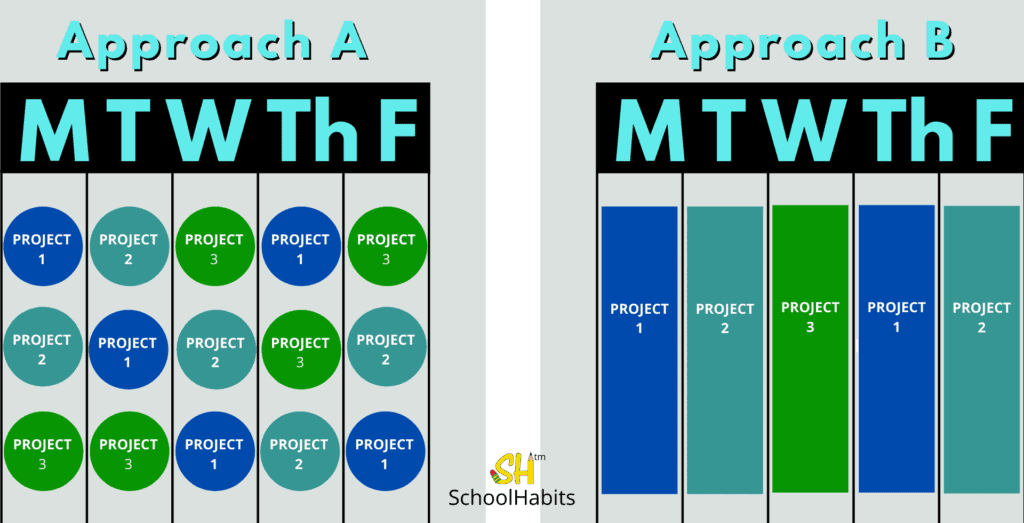By Katie Azevedo, M.Ed.
Whether you’re a student or a working professional, you need to know how to handle multiple projects at the same time.
No matter your age or experience, there are going to be weeks when you have to juggle a report for one class or boss, a presentation or essay for another teacher, a research something-or-other for a third person – all at once.
If you’d rather watch me explain this strategy in my video tutorial, you can find that here.
While you may want to shut down and hide when these chaotic moments strike, that’s the last thing you should do. With a little planning and organization, you can handle multiple projects at the same time. Here, I’m showing you how.
When you have multiple large assignments or projects on your plate, you essentially have two project-management options. I explain them both below.
… But before I do, I’m going to start with a seriously important reminder: the key to managing any amount of projects is staying organized.
The more we have going on, the more organized we have to be. If you have to manage three separate projects, you have to be game-on with how you organize your materials.
For starters, for every project you’re working on, you need a completely separate collection of stuff. Even if you could fit all the materials for all your projects together, don’t. Below are some organization ideas.
If your materials are all online:
- Keep your files clearly labeled and grouped into distinct folders
- Use a simple and consistent naming convention for all files related to a particular project
- Consider using a [project management tool like Asana, Trello, or Evernote (I personally use Asana to manage my business tasks)
- Regularly edit and cull your materials (ie throw things away)
If your materials are analog (paper-based):
- Keep all files related to a project in separate folders
- Use separate notebooks for project notes (do not use the same notebook for more than one project. You can get cheap notebooks for $1 at many discount stores)
- Group related papers (part of the same project) together with clips
- Regularly edit and cull your materials (i.e. throw things away)
- When you’re done working on a particular project, be diligent about properly putting away all your materials so you can easily find them next time.
How to manage multiple projects at the same time: 2 approaches
One approach is not better than the other. You should choose the one that makes sense for your schedule, your job, the actual projects you have to manage, and your personal preferences. You can use one approach sometimes, and the other one a different time. If your primary issue is starting projects, then use these tips before you read on.
Here are the two project-management approaches:
- Work on each project a little bit each day
- Work on one project per day
Yes, at first glance the approaches are almost too simple. But there are rules to follow.
Approach A
1. Work on each project a little bit each day. You essentially take the amount of available time you have in a day, divide by the number of projects you have, and then work on each project for around the same amount of time.
You have 4 hours and 3 projects? Divide 4 by 3 and you get an hour and twenty minutes per project.
2. Never go back to a project on the same day. You move from one project to another, to another, to another. But it’s critical that you avoid going back to a project once you’ve moved on from it. When you’re done with one thing for the day, you are done. Wrap it up, put away your materials, put a sticky note somewhere about where you left off so you know exactly where to pick up tomorrow, and then move to the next thing.
It’s important not to go back and forth between projects, because doing so breaks the flow of concentration, sets you up for procrastination, and subconsciously gives you toxic permission not to do something because you think you can “just do it a little later.” When you know that you have ONE shot in the day to crank out your stuff, you’re more likely to do it.
A benefit to this approach is that you can chip away at each project each day, and that can make us feel accomplished.
3. Take breaks between each project. A general rule of thumb is to take a 10 minute break for every 45 minutes of cognitively demanding work, or a 15 minute break for every 60-90 minutes of lighter work.

Approach B
1. Work on just one project per day. You dedicate the whole day — or whatever available amount of time you have that day — to just one thing.
Then the next day, you work on another project, and only on that project.
2. Works best when you have 3 projects or less going on. Any more than that, and too much time will pass before we return to a project. For example, if we have four large assignments, then we’ll only get to each one every 4 days; that is too long in most cases. In that amount of time, we forget where we left off and we lose momentum.
With this method, you avoid that lag time that happens when you switch from one thing to the next, to the next. Depending on how intense our projects are, how our brains work and our personal preferences, some of us may feel too “fragmented” with Approach A.
3. Take breaks throughout the day. I’ll repeat what I wrote above: A general rule of thumb is to take a 10 minute break for every 45 minutes of cognitively demanding work, or a 15 minute break for every 60-90 minutes of lighter work.
Try the Pomodoro Technique for a proven time-management technique for structuring breaks.
If you were looking for strategies for how to handle multiple projects at the same time, found this post, and are thinking that these two approaches are too simple for what you need, then I challenge you to reconsider. The best strategies are the simplest. The best tips don’t involve a million tools or have a million rules.
Fewer bells and whistles yield more time for work.
Bonus Resource: How to Get an A on Your Final Projects: 5 Tips for Students

